There are 6 different types of skinks in Missouri. You can find many species all over the state, while some species have more restricted ranges.
The skinks in Missouri tend to live in moist habitats. Most species favor places with lots of logs and leaf litter. These areas also provide an abundance of insects and small arthropods to eat.
This article will discuss all the species you can find in this state and exciting facts about each one. If you have ever been curious about these fascinating creatures, you will find all the answers you need here.
Skinks are shy, secretive animals. Although some species may seem threatening because of their patterns or snake-like bodies, these lizards are entirely harmless. It is true that some bite when attacked. But, more often than not, these lizards run at the slightest sign of a threat.
Skinks are easy reptiles to care for because they have simple dietary needs. Many are excellent fits for home terrariums, but their specific needs tend to slightly differ by species.
You can tell the different skinks in Missouri apart by knowing their color, pattern, behavior, and preferred habitat. Thankfully, this article covers all these things.
Table of Contents
Skinks in Missouri
1. Coal Skink
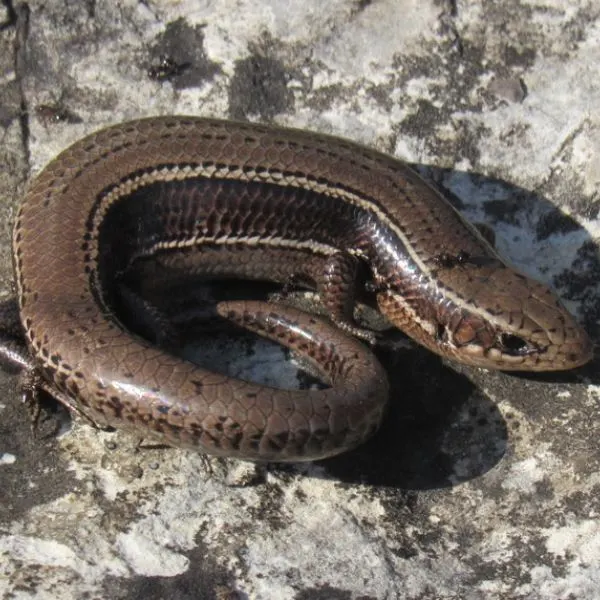
- Experience Level: Advanced
- Family: Scincidae
- Scientific Name: Plestiodon anthracinus
- Other Names: Coal Skink, Black Skink
- Adult Size: 5 to 7 inches
- Lifespan: 6+ years
- Average Price Range: N/A
Coal skinks are the shiest skinks in Missouri and many other states.
These lizards often stay out of sight and are masters at evading predators. So finding them even in their natural ranges can be quite a challenge.
Coal skinks live in moist forest areas not far from the shores of streams and ponds. These habitats tend to have plenty of leaf litter and debris they can easily hide under.
You will hardly find these skinks basking in open areas. They sometimes do, but they do not stay exposed for too long. Instead, they spend most of their time under leaves or debris.
A coal skink will run for cover when you approach it. Unlike many other skinks in Missouri, these shelters are not strictly terrestrial. Many dive into streams when people approach them.
Biologists do not know much about these lizards because they are hard to observe in nature. Their population in Missouri is minute. But if you are bent on finding one, you are more likely to in the southern part of the state.
The young of this species are visually stunning. The lizards’ skins are coal-black, which is how they get their names. They also have bright blue or purplish tails.
Most coal skink hatchlings lack light lines or only have faint traces. However, heads typically have tiny white markings.
Adults have a brown ground color with four thin light lines on either side. Each pair of thin lines has a broad, dark stripe in the middle. Adults also lack the bright blue tails of juveniles.
You can feed coal skinks with beetles, spiders, crickets, termites, and other arthropods. Many also snack on whatever crustaceans they can find by the streams.
2. Great Plains Skink
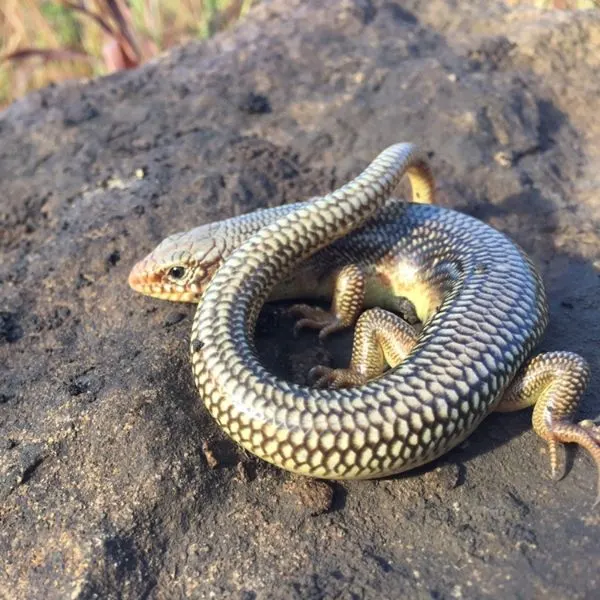
- Experience Level: Advanced
- Family: Scincidae
- Scientific Name: Plestiodon obsoletus
- Other Names: N/A
- Adult Size: 6 to 14 inches
- Lifespan: 3 to 8 years
- Average Price Range: N/A
Great Plains skinks are the biggest skinks in Missouri. They have tan to gray bodies, but you can quickly tell them apart from other species in the state by their patterns.
This species has smooth cycloid scales with black crescent-shaped outlines. The black outlines are most pronounced at the sides of each scale, creating several jagged lines on its body. The outlines of its scales also create a distinct net pattern.
The back of this skink is tinged with pink, while the tail and limbs are slightly yellow. In addition, Great Plains skinks have oblique scale rows on each side instead of the horizontal rows on other skinks in the state.
Adult and juvenile Great Plains skinks are so different that taxonomists initially considered them separate species. Juveniles are typically jet-black with bright blue tails and white markings on their heads.
Sadly, Great Plains skinks are a species of conservation concern in Missouri. They have sparse populations, so you will rarely find them anywhere in the state. However, you may be lucky to find one or two in the western counties in peak summer.
You can find these lizards in open prairies and flood plains in the wild. They burrow a lot, so they do not spend much time basking. This habit saves you money on installing UV lighting if you intend to keep one in an enclosure.
The coloration and pattern of this lizard make it a delight to look at any age. However, it is not cuddly.
Great Plains skinks dislike being touched and tend to bite when picked up. Considering the size of Great Plains skinks, the bites will hurt quite a bit.
You can feed Great Plains skinks with insects like roaches, crickets, beetles, and other arthropods. In particular, many species enjoy snacking on giant grasshoppers or locusts.
3. Common Five-lined Skink
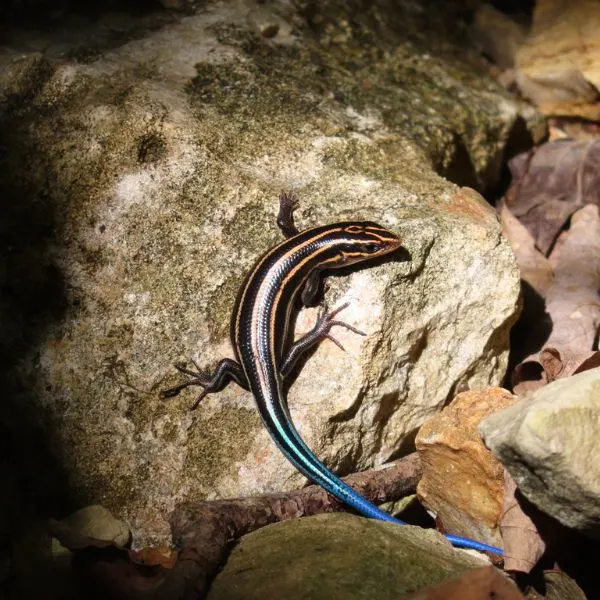
- Experience Level: Beginner to Intermediate
- Family: Scincidae
- Scientific Name: Plestiodon fasciatus
- Other Names: American Five-lined Skink, Five-lined Skink
- Adult Size: 5 to 8.5 inches
- Lifespan: 6 to 10 years
- Average Price Range: N/A
You can find five-lined skinks all over Missouri, except in the far northern counties. These lizards have tan to brown bodies with five light lines running down their back and sides.
Adult males typically have only traces of these lines, but you may also come across many with no hint left. However, the stripes are prominent in adult females and juvenile five-lined skinks.
Juvenile five-lined skinks have a black ground color and bright blue or purple tails. Sadly, this pleasing tail coloration fades as they mature into adults. Their stripes are also much lighter than those of adult females.
Adult males are aggressively territorial towards other males. However, they let females into their territories. Their heads also take on a bright red-orange tint during breeding seasons.
You will often find these skinks in areas with plenty of moisture. They are common in forests abundant with fallen trees, rotting logs, and other debris. However, it is common to find them in many different habitats, including residential areas.
Five-lined skinks spend plenty of time on the ground, but they also love to climb. They tend to climb trees to search for food or bask in the sun. In residential areas, you may find them basking on the walls or foraging in people’s gardens.
Despite this closeness to humans, these lizards are not fond of being touched. They are great for home terrariums, but they tend to run or bite when owners try to pet them.
If you decide to keep one, ensure its terrarium has sufficient vegetation. The enclosure should include hiding and basking spots to make the lizard comfortable. Then, finish by setting up UV lighting for the skink to bask in.
You can feed five-lined skinks with various types of arthropods. They also eat other small invertebrates like waxworms and mealworms.
4. Broadhead Skink
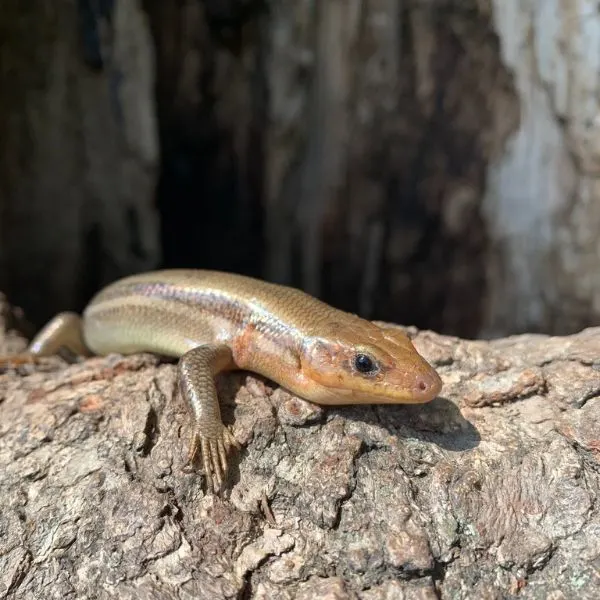
- Experience Level: Advanced
- Family: Scincidae
- Scientific Name: Plestiodon laticeps
- Other Names: Broadhead Scorpion, Five-lined Skink
- Adult Size: 6 to 13 inches
- Lifespan: 6 to 10 years
- Average Price Range: N/A
Broadhead skinks are also a type of five-lined skink. If you’re not an expert, you may have trouble differentiating the two species.
Adult male broadhead skinks are easier to identify. Identification is easy because they have distinctly wide, triangular jaws that broaden their heads. Hence the name broadhead.
Adult female and juvenile broadhead skinks are harder to tell apart from other five-lined species. That is because they both have five thin stripes running down their back and sides.
Like other five-lined skinks, juvenile broadheads have bright blue tails and black bodies. The tail coloration fades in adulthood, and the black ground color lightens to brown. However, adult females remain much darker than males.
The best way to distinguish broadhead skinks is to count their facial scales. Broadhead skinks have no enlarged post-labial scales. Instead, 1 labial scale extends to touch the ear. Other five-lined skinks have 2 post-labial scales.
Broadhead skinks are the second-largest skinks in Missouri. They are not as abundant as common five-lined skinks, but you can find them throughout the state except the far north.
These lizards are the most arboreal skinks in Missouri. They sometimes stay on the ground, but you are more likely to find them basking on trees in their natural habitat.
This skink’s natural habitat is typically moist and populated with standing trees. Most live in hardwood forests close to streams or rivers.
They have essentially the same traits as common five-lined skinks. Adult males are aggressive towards other males and welcoming to females. During breeding seasons, males also develop bright red-orange heads.
You can keep this skink for display in a terrarium. Ensure this terrarium is as close to its natural habitat as possible, which means adequate UV lighting and basking spots.
Like most skinks in the state, broadheads are not fond of handling.
5. Ground Skink
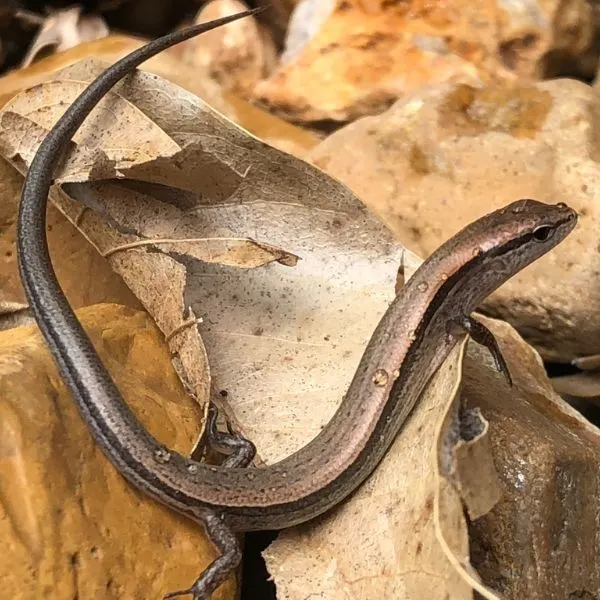
- Experience Level: Advanced
- Family: Scincidae
- Scientific Name: Scincella lateralis
- Other Names: Little Brown Skink
- Adult Size: 3 to 5.75 inches
- Lifespan: 2 to 4 years
- Average Price Range: N/A
In contrast to broadhead skinks, ground skinks are the least arboreal skinks in Missouri. They get their name from their penchant for staying on the ground. These skinks do all their foraging and basking on the floor without climbing trees.
Ground skinks are fond of places with many fallen trees and leaf litter. They spend most of their time traveling under cover of this litter, so they can be hard to spot in their habitats.
These lizards have modified eyes that allow them to move seamlessly under debris. Their lower eyelids are transparent enough to see through even with closed eyes. This feature distinguishes them from all other skinks in Missouri.
Also called little brown skinks, these lizards are generally golden to dark brown. However, most species you will find in the wild are copper brown with black lateral stripes that run from snout to tail.
These lizards also have white to yellow undersides. Males do not look different from females, and the body pattern is consistent across all life stages.
Little brown skinks move incredibly fast, which makes catching them a challenge. In addition, their habit of staying under the cover of leaves also allows them to escape before you even know they were there.
These reptiles are unsuitable for personal keeping due to their minute sizes and brief lifespan. As a result, many people who catch them sell them as feeder lizards for snakes.
You can find little brown skinks throughout Missouri, except the northwestern parts. These lizards eat beetles, beetle larvae, roaches, and other types of arthropods. In turn, they are eaten by various kinds of animals—including some bird hatchlings.
6. Prairie Skink
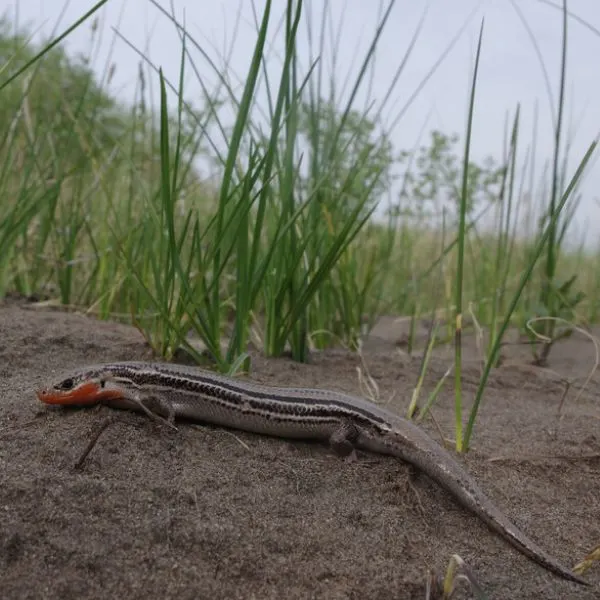
- Experience Level: Advanced
- Family: Scincidae
- Scientific Name: Plestiodon septentrionalis
- Other Names: Northern Prairies Skink, Southern Prairie Skink
- Adult Size: 4 to 8 inches
- Lifespan: Up to 7 years
- Average Price Range: N/A
As the name suggests, this skink lives in prairies in some parts of Missouri. It occurs as two subspecies here: the northern prairie skink (P. s. septentrionalis) and southern prairie skink (P. s. obtusirostris).
Sadly, the two subspecies are species of conservation concern due to their tiny populations. In addition, the destruction of prairies caused by urbanization contributes to the decline of these lizards in the state.
Until recently, only northern prairie skinks were recognized in Missouri. You can only find them in one northwestern Missouri county. Southern prairie skinks have only been recently discovered in the state, so biologists know little about their natural ranges.
Prairie skinks are shy lizards that tend to stay hidden under rocks or debris. Juveniles are black and have seven thin white to yellow lines with bright blue tails. The lines and tail color fade as the lizard matures, and the black ground color lightens to brown or brownish gray.
Female adults are generally darker than males. Both typically have pattern-free backs with two light lines on each side. Each pair of thin lines has a broad, dark stripe in the middle.
You can tell prairie skinks apart from other skinks with four lines by their scales and patterns.
Unlike coal skinks whose stripes extend out their snouts, prairie skinks’ light and dark lines do not extend to the snout. Prairie skinks also have 2 postmental scales in contrast to the 1 coal skinks have under their chins.
Both prairie skink subspecies look identical. However, northern prairie skinks have darker broad stripes and are slightly bigger.
These lizards have the same diet as other skinks. So you can feed them with roaches, spiders, and other arthropods.
Frequently Asked Questions
You probably have many questions about the skinks in Missouri after reading this article. Or maybe you need clarifications about specific issues.
This section contains clear answers to all your questions.
How do you identify skinks?
You can identify skinks by their scales and body pattern. Skinks have slender bodies and long tails. They often lack distinct heads, and their limbs are smaller than most lizards’. They also have smooth, glossy scales. These scales may appear to shine on sunny days.
How rare are skinks in Missouri?
The rarity of skinks in Missouri depends on the species. Some species, such as coal and prairie skinks, are rarely encountered in the state. Others are more common. For instance, you can find five-lined skinks almost anywhere in the state.
What do skinks in Missouri eat?
The skinks in Missouri mainly eat arthropods like crickets, spiders, and beetle. However, these lizards also eat tiny invertebrates, such as worms.
Skinks may occasionally feed on other small vertebrates, including lizards of their species. For example, broadheads sometimes eat their immature young.
If you have a skink in your terrarium, you may add some fruits and vegetables to the lizard’s diet once in a while. Fortunately, skinks are not the pickiest eaters.
Are skinks in Missouri poisonous?
No. The skinks in Missouri are not poisonous. No skink in the world is. These slender lizards are entirely safe to have around. However, they may bite you if you mishandle or threaten them.
The bite from larger species with powerful jaws can be painful, but even this pain is negligible. Thankfully, it does not contain any venom, so you have nothing to worry about.
Where are skinks found in Missouri?
You can find skinks in Missouri in most parts of the state. However, the distribution of these lizards is highly species-dependent. For example, broadhead and five-lined skinks range throughout most of the state but avoid the far north.
Others like coal skinks are more restricted to a fraction of the south, so you rarely encounter them in other areas.
If you are looking for a particularly skink species, make sure to read about its distribution within the state before going on your next adventure.
Can you own a pet skink in Missouri?
Yes. You can apply for permits to own some skinks in Missouri. Permits cost money, but you can get them for species like five-lined skinks. Sadly, species of conservation concern are ineligible for such licenses. So you cannot legally keep species like coal skinks, prairie skinks, and Great Plains skinks as pets in this state.
Wrapping up
The skinks in Missouri are a highly diverse set. Consequently, the species you will find here differ significantly from each other. So it is best to understand those differences if you intend to keep any.
Unfortunately, many of the skinks in Missouri are species of conservation concern. Urbanization and habitat destruction continue to reduce the already minute numbers of several species.
If you find more abundant species around your home, such as five-lined skinks, try not to disturb them. All skinks are harmless. They may even help you control pests since they eat many insects and arthropods.
These lizards have developed a fascinating way of escaping potential predators that involves breaking off their tails when chased or grabbed. The tails thrash about for a while, distracting the predator while the lizards make their escape.
Skinks tend to regenerate lost tails, but it comes at a cost. So if you encounter one on your next adventure, do not be the reason it loses its tail.
Skinks in other states
